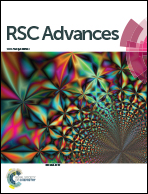Oxidative coupling of 2-naphthol by zeolite-Y supported homo and heterometallic trinuclear acetate clusters†
Abstract
Two trinuclear acetate clusters of iron and cobalt of general formula [Fe3O(O2CCH3)6(H2O)3]NO3·2H2O and Fe2Co(O)[(OOCC6H4NO2)6]NO3·2H2O are synthesized and characterized. The synthesized trinuclear clusters are supported on zeolite-Y via an ion exchanged method. FTIR study reveals that the two complexes are tethered via formation of Si–O–H⋯O–H hydrogen bond linkages with a zeolite-Y matrix. Homogeneous and heterogeneous trinuclear catalysts are found to be efficient catalysts for oxidative coupling of 2-naphthol. Compared to homometallic oxo-clusters, bimetallic complexes are found to show better catalytic activity. Besides obtaining BINOL as a major product, these metal clusters also lead to formation of the tautomeric form of BINOL. The crystal structure of the by-product indicates the formation of a tetrahedral chiral centre in the molecule via the attachment of the solvent. Density Functional Theory (DFT) calculations have been performed to elucidate the structural and electronic properties of both homogeneous and heterogeneous complexes.


 Please wait while we load your content...
Please wait while we load your content...